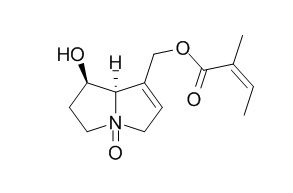9-Angeloylretronecine N-oxide
Reference standards.
Inquire / Order:
manager@chemfaces.com
Technical Inquiries:
service@chemfaces.com
Tel:
+86-27-84237783
Fax:
+86-27-84254680
Address:
1 Building, No. 83, CheCheng Rd., Wuhan Economic and Technological Development Zone, Wuhan, Hubei 430056, PRC
Providing storage is as stated on the product vial and the vial is kept tightly sealed, the product can be stored for up to
24 months(2-8C).
Wherever possible, you should prepare and use solutions on the same day. However, if you need to make up stock solutions in advance, we recommend that you store the solution as aliquots in tightly sealed vials at -20C. Generally, these will be useable for up to two weeks. Before use, and prior to opening the vial we recommend that you allow your product to equilibrate to room temperature for at least 1 hour.
Need more advice on solubility, usage and handling? Please email to: service@chemfaces.com
The packaging of the product may have turned upside down during transportation, resulting in the natural compounds adhering to the neck or cap of the vial. take the vial out of its packaging and gently shake to let the compounds fall to the bottom of the vial. for liquid products, centrifuge at 200-500 RPM to gather the liquid at the bottom of the vial. try to avoid loss or contamination during handling.
Mol Biol Rep.2024, 51(1):117.
Academic J of Second Military Medical University2019, 40(1)
Cell Death Discov.2023, 9(1):350.
Cell Commun Signal.2024, 22(1):597.
Fitoterapia.2022, 105141.
Toxins (Basel).2019, 11(10):E575
J Mol Recognit.2020, 33(2):e2819
Braz J Med Biol Res.2021, 54(12):e11183.
J of Applied Pharmaceutical Science2020, 10(1):077-082
Eur Endod J.2020, 5(1):23-27.
Related and Featured Products
Phytochemistry Letters, 2016:S1874390016303202.
Comparative HILIC/ESI-QTOF-MS and HPTLC studies of pyrrolizidine alkaloids in flowers of Tussilago farfara and roots of Arnebia euchroma.[Reference:
WebLink]
The utility of HPTLC and HILIC/ESI-QTOF-MS for the determination of pyrrolizidine alkaloids (PAs) and their N-oxides (PANOs) was compared in the selected plant species: Tussilago farfara L. (TF, flower) and Arnebia euchroma (Royle) I.M. Johnst. (AE, root). HPTLC confirmed the postulated presence of PAs (saturated and unsaturated) or PANOs in the tested extracts.
METHODS AND RESULTS:
In accordance with previous studies, HILIC/ESI-Q-TOF-MS confirmed the presence of the toxic PA senkirkine and the saturated otonecine-type PAs, tussilagine and isotussilagine in the TF extract and 7-angeloylretronecine and 9-angeloylretronecine in AE extract. Moreover, the following alkaloids were identified in AE root: intermedine, intermedine-N-oxide, leptanthine-N-oxide, echimidine-N-oxide (or their corresponding stereoisomers) and traces of 7-angeloylretronecine and 9-Angeloylretronecine N-oxide.
CONCLUSIONS:
The study demonstrates the HILIC/ESI-Q-TOF-MS method to be a very useful tool for monitoring PAs and PANOs in the test samples, even when not all of the necessary standards are available. Quantitative analysis of senkirkine in TF flower by HILIC/ESI-QTOF-MS featured high resolution, high precision, high mass accuracy, and very high sensitivity with limit-of-detection (LOD) of 27.50 fg/μL and limit-of-quantitation (LOQ) of 91.60 fg/μL. The results from both methods may be used for the development or rejection of European Pharmacopoeia (X) monographs of both investigated species.



